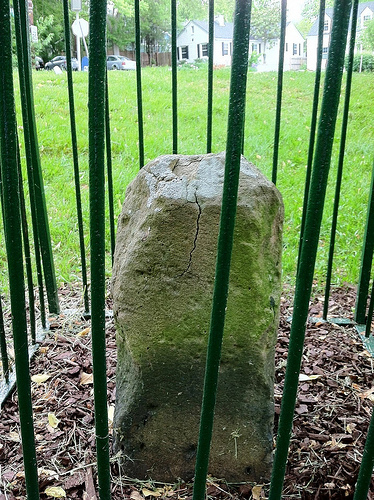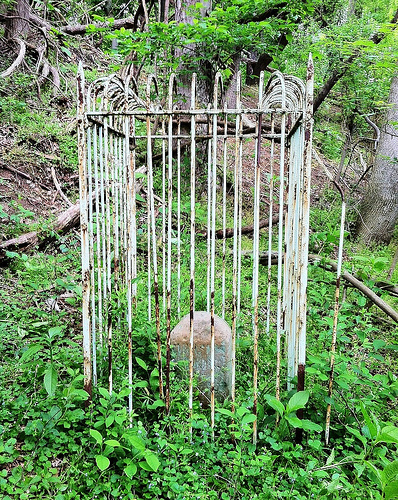Without preservation, DC’s boundary stones are in danger
The first monuments of the nation’s capital still stand, after enduring earthquakes, tornadoes, floods, and blizzards, target practice for bored encamped Civil War troops, wayward vehicles, and vandalism.
In 1791 and 1792, 40 Aquia Creek quarried sandstones, forming the perimeter of the federal 10-mile square, were placed in the ground. 36 original stones have withstood the test of time, but their future is in danger.
Tireless volunteers and vigilant homeowners have maintained the boundary stones for the better part of more than 200 years, but there is no funding to ensure the stones get preserved for the long term. DDOT is responsible for the stones and received federal money in 2005 to preserve the stones, but the funding has disappeared.
The stones have survived more than two centuries, but conditions vary from stone to stone. Made of sandstone, a soft sedimentary rock, many stones still bear the “Jurisdiction of the United States” engraving and the year they were placed. For others the inscriptions have worn off over time.
Surrounding vegetation, undeterred by the fences that buttress the stones, has eroded numerous stones while the stones on a grassy plane are in the best condition. Through small cracks in some stones, similar to potholes in the street, water has seeped in, fragmenting the stone, such as on stone NW#6:

Boundary Stone NW #6, near the intersection of Western Avenue and Fessenden Streets, NW. Photo by the author.
The most immediate and practical solution would be to install a canopy over each stone, similar to the canopies that in recent years have ensconced Metro station entrances.
Making stones National Historic Landmarks would aid preservation
In the early 1990s, all 26 of the stones on the DC-Maryland border (23 of the originals are still in the ground, while one is in a basement in Colesville, MD) were added to the National Register of Historic Places.
National Historic Landmark designation, a further step, would make it easier to obtain grant funding to preserve the stones. It would also bring National Park Service technical assistance and monitoring of the stones’ condition. But thus far, only one stone, SW#9 in Falls Church, is a National Historic Landmark.
Stephen Powers, acting co-chairman of the Nation’s Capital Boundary Stones Committee (NACABOSTCO), says the organization is currently developing an application to submit the Boundary Stones for National Historic Landmark status.
DDOT gets money to restore stones, but funds disappear
DDOT actually legally owns the stones, according to Ric Terman, co-chair of NACABOSTCO. In June 2003, DDOT’s Chief Engineer at the time, John Deatrich, accepted legal responsibility for the DC-Maryland stones after Department of the Interior officials determined that a 3-foot easement around each stone was federal property to be overseen by DDOT.
Terman says that acquiring a National Historic Landmark for all 26 stones was part of the draft Memorandum of Agreement between multiple city, state, and federal agencies.
In 2005, DDOT announced that they had been awarded a $200,000 Transportation Enhancement (TE) grant from the Federal Highway Administration (FHWA) to preserve the stones that mark the DC-Maryland border. In 2006, DDOT presented a draft scope of work for the project, funded by $160,000 in TE money and $40,000 of local funds, predicting an August 2006 start date. Later that year, a Draft Memorandum of Agreement was circulated between DDOT, FHWA, and the National Park Service to “inventory, evaluate, preserve, and restore the original sandstone markers.”
Six years later, DDOT hasn’t started the project, it’s not clear whether anyone signed the Memorandum of Agreement, and the funding for the project appears to be gone.
“At this time, DDOT does not have funding for marker improvements, but we will be working with District agencies, our Federal partners, and other interested groups to develop a comprehensive approach to preserving the monuments,” Maurice Keys, DDOT’s Chief of Strategic Planning for Planning, Policy and Sustainability Administration, wrote to Jane Waldmann, of the Tenleytown Historical Society, in January.
Keys recently said, “DDOT does not maintain the stones. Volunteer groups have taken responsibility for maintaining a number of the monuments. DDOT recently requested approval of funding from the Federal Highway Administration to inventory and assess the condition of the monuments.” What happened to the $200,000 TE grant that FHWA awarded in 2005?
Barry speaks up for the stones
Largely out of sight, out of mind, the Boundary Stones that lie in Ward 8 have found a vocal champion on the DC City Council: Ward 8 Councilmember Marion Barry.
“The Boundary Stones are an important part of our history in the District of Columbia,” Barry said. “We take this responsibility very seriously. I am thrilled that these small monuments of our heritage have finally been brought to the forefront and given the recognition that they so greatly deserve.”
Without public funding and attention from the city, it has largely fallen to private citizens and bi-annual service events led by Powers to maintain the stones. Chapters of the DC Daughters of the American Revolution have helped with full-scale restoration projects at a handful of stones, and the American Society of Civil Engineers, National Capital Section has provided over $3,000 to restore and paint fences around 20 stones.
The efforts of these volunteers are crucial, but it’s time to get the stones designated as National Historic Landmarks and for DDOT to help the Boundary Stones get the attention and protection they deserve.


